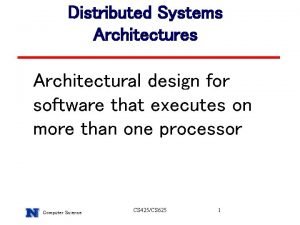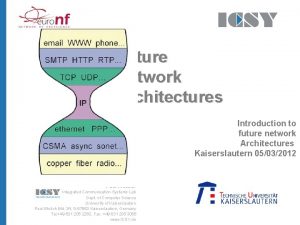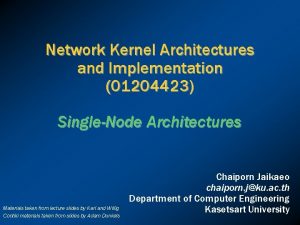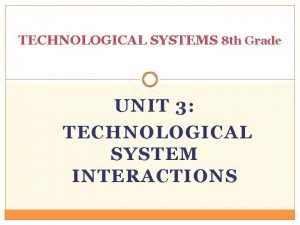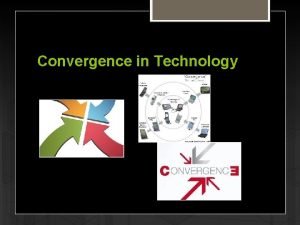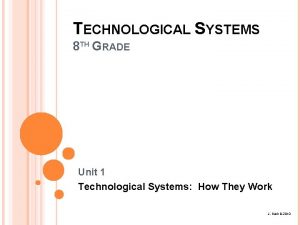Future Network Architectures Technological Challenges and Trends Section






























- Slides: 30

| Future Network Architectures Technological Challenges and Trends Section 1 Introduction Section 2 Capacity, Efficiency, Performance, Ubiquity, Scalability and. Generality Section 3 Identification, Mobility and Localization Section 4 Adaptability, Autonomicity, Self-*, *-Aware and Manageability Section 5 Semantic, Context, Naming and Routing Section 6 Security, Privacy, Trust, Transparency, Anonymity, and Safety Section 7 Section 8 Neutrality, Openness, Diversity, Extendibility, Flexibility and Usability Simplicity, Sustainability and Evolvability

Future Network Architectures Section 1 Section 2 Section 3 Section 4 Section 5 Section 6 Section 7 Section 8 | Introduction 1 Introduction Point of view • Technological requirements, • Challenges and • Trends towards future network architectures

Future Network Architectures Section 1 Section 2 Section 3 Section 4 Section 5 Section 6 Section 7 Section 8 | Introduction

Future Network Architectures | Capacity, Efficiency, Performance, Ubiquity, Scalability and Generality

Future Network Architectures Section 1 Technologies : Section 2 Section 3 Section 4 Section 5 Section 6 Section 7 Section 8 | Capacity, Efficiency, Performance, Ubiquity, Scalability and Generality Storage capacity (solid state flash memories and high capacity magnetic disks) Polymer memories, could increase storage capacity even more. Reducing chips energy consumption. Dye-sensitized solar cells for mobile devices (Alt. Energy) High-performance computing based on supercomputers or computer clusters.

Future Network Architectures Section 1 Section 2 Section 3 Section 4 Section 5 Section 6 Section 7 Section 8 | Capacity, Efficiency, Performance, Ubiquity, Scalability and Generality Creating ultrafast processors. Better quality and larger screens Improving the quality of experience and allowing new forms of digital interactivity. Silicon photonics, Micro-Electro. Mechanical Systems (MEMS), nanotechnology, Nanoelectromechanical Systems (NEMS), quantum computing and communications, carbon nanotubes, etc.

Future Network Architectures Section 1 Section 2 Section 3 Section 4 Section 5 Section 6 Section 7 Section 8 | Capacity, Efficiency, Performance, Ubiquity, Scalability and Generality Problem : Heterogeneity of devices will prevail Shortage of IPv 4 addresses Traffic growth Several technologies to deal with the problem : Classless Inter-Domain Routing (CIDR) Network Address Translation (NAT) Dynamic Host Configuration Protocol (DHCP) IPv 6 Fiber-To-The-Home (FTTH)

Future Network Architectures Section 1 Section 2 Section 3 Section 4 Section 5 Section 6 Section 7 Section 8 | Capacity, Efficiency, Performance, Ubiquity, Scalability and Generality

Future Network Architectures Optical Networking Wireless Networking Virtualizatio | Capacity, Efficiency, Performance, Ubiquity, Scalability and Generality 2. 1 Optical Networking Technologies Ultra-Dense Wavelength Division Multiplexing (UDWDM) Optical Time Division Multiplexing (OTDM)

Future Network Architectures | Year Organization Effective Speed WDM Channel s Per Channel Speed Distance (Km) 2009 Alcatel-Lucent 15 Tbit/s 155 100 Gbit/s 90 2010 NTT 69. 1 Tbit/s 132 171 Gbit/s 240 2011 KIT 26 Tbit/s 1 26 Tbit/s 50 2011 NEC 101 Tbit/s 370 273 Gbit/s 165 2012 NEC, Corning 1. 05 Petabit/s Optical Networking Wireless Networking Virtualizatio Capacity, Efficiency, Performance, Ubiquity, Scalability and Generality 12 core fiber 52, 4 In 2013, New Scientist reported that a team at the University of Southampton had achieved a throughput of 73. 7 Tbit per second, with the signal traveling at 99. 7% the speed of light through a hollow-core photonic crystal fiber.

Future Network Architectures Optical Networking Wireless Networking Virtualizatio | Capacity, Efficiency, Performance, Ubiquity, Scalability and Generality

Future Network Architectures Optical Networking Wireless Networking Virtualizatio | Capacity, Efficiency, Performance, Ubiquity, Scalability and Generality

Future Network Architectures Optical Networking Wireless Networking Virtualizatio | Capacity, Efficiency, Performance, Ubiquity, Scalability and Generality RF technologies : Multiple-Input and Multiple-Output (MIMO) Ultra-Wide Band (UWB) Orthogonal Frequency Division Multiplexing (OFDM) Antennas

Future Network Architectures Optical Networking Wireless Networking Virtualization | Capacity, Efficiency, Performance, Ubiquity, Scalability and Generality

Future Network Architectures Optical Networking Wireless Networking Virtualization | Capacity, Efficiency, Performance, Ubiquity, Scalability and Generality

Future Network Architectures Optical Networking Wireless Networking Virtualization | Capacity, Efficiency, Performance, Ubiquity, Scalability and Generality

Future Network Architectures Section 1 Section 2 Section 3 Section 4 Section 5 Section 6 Section 7 Section 8 | Problem : DHCP Limit of IPv 4 Identification, Mobility and Localization

Future Network Architectures Section 1 Section 2 Section 3 Section 4 Section 5 Section 6 Section 7 Section 8 | Identification, Mobility and Localization 4, 294, 967, 296 possible IP

Manual Software-Defined Wifi a, b, g, n (Short and limit bandwidth) Mobile(1 G, 2 G/GPRS/ED GE, 3 G/1 x. EVDO, 3. 5/HSDPA/EV-DO) Security Wi. MAX (40 Km) Mobile(4 G/3 G and beyond) UTP Coaxial Optic (Backbone) All optic fiber(Fiber To The Home)

Future Network Architectures Section 1 Section 2 Section 3 Section 4 Section 5 Section 6 Section 7 Section 8 | Adaptability, Autonomicity, Self-*, *-Aware and Manageability

Future Network Architectures Section 1 Section 2 Section 3 Section 4 Section 5 Section 6 Section 7 Section 8 | Adaptability, Autonomicity, Self-*, *-Aware and Manageability

Future Network Architectures Section 1 Section 2 Section 3 Section 4 Section 5 Section 6 Section 7 Section 8 | Adaptability, Autonomicity, Self-*, *-Aware and Manageability

Future Network Architectures Section 1 Section 2 Section 3 Section 4 Section 5 Section 6 Section 7 Section 8 | Adaptability, Autonomicity, Self-*, *-Aware and Manageability

Future Network Architectures Section 1 Section 2 Section 3 Section 4 Section 5 Section 6 Section 7 Section 8 | Semantic, Context, Naming and Routing Semantic Web "Semantics is the technical term used to refer to the study of meaning, and since meaning is a part of language, semantics is a part of linguistics. “ Semantic Web is not about links. Semantic Web describes the relationships between things (like A is a part of B and Y is a member of Z) and the properties of things (like size, weight, age, and price).

Future Network Architectures Section 1 Section 2 Section 3 Section 4 Section 5 Section 6 Section 7 Section 8 | Semantic Web Semantic, Context, Naming and Routing

Future Network Architectures Section 1 Section 2 Section 3 Section 4 Section 5 Section 6 Section 7 Section 8 | Problem : computer viruses, worms, trojans, spyware, dishonest adware, phishing, spam, spoofing, code injection, etc Security, Privacy, Trust, Transparency, Anonymity, Accountability and Safety

Future Network Architectures Section 1 Section 2 Section 3 Section 4 Section 5 Section 6 Section 7 Section 8 | Neutrality, Openness, Diversity, Extendibility, Flexibility and Usability

Future Network Architectures | Simplicity, Sustainability and Evolvability Section 1 Section 2 Section 3 Section 4 Section 5 Section 6 Section 7 Section 8 Design must be kept simple and unnecessary complexity should be removed. Simplicity is the ultimate sophistication Allow new approaches to replace established ones, reducing unnecessary complexity and increasing efficiency and quality simplicity is achieved by refinement/ evolution

End of Slide|Future Network Architectures

Future Network Architectures | Simplicity, Sustainability and Evolvability References Tania Tronco (Ed. ), New Network Architectures, springer, 2010 Antˆonio Marcos Alberti, Future Network Architectures: Technological Challenges and Trends, springer WANG Wendong, et. al, Autonomicity Design in Open. Flow Based Software Defined Networking, The 4 th IEEE International Workshop on Management of Emerging Networks and Services, 2012
 Ihrm trends
Ihrm trends Future trends and challenges of hrm
Future trends and challenges of hrm Backbone network architectures
Backbone network architectures Backbone network architectures
Backbone network architectures Future perfect time
Future perfect time Future perfect future continuous future perfect continuous
Future perfect future continuous future perfect continuous Current future trends of media and information
Current future trends of media and information Challenges of emerging trends in operating systems
Challenges of emerging trends in operating systems Database storage architecture
Database storage architecture Autoencoders
Autoencoders Google mapia
Google mapia Product architecture diagram
Product architecture diagram Ansi/sparc
Ansi/sparc Theo schlossnagle
Theo schlossnagle Integral product architecture example
Integral product architecture example Gui architectures
Gui architectures Database system architectures
Database system architectures Cdn architectures
Cdn architectures Scalable web architectures
Scalable web architectures Different olap architectures
Different olap architectures Instruction set architectures
Instruction set architectures Internet client server application in e commerce
Internet client server application in e commerce Banking system architecture diagram
Banking system architecture diagram Gpu cache coherence
Gpu cache coherence Why systolic architectures
Why systolic architectures Assembly by anne bell
Assembly by anne bell Chapter 9, section 1: labor and wages worksheet answers
Chapter 9, section 1: labor and wages worksheet answers Future perfect and future continuous examples
Future perfect and future continuous examples Tense chart
Tense chart Future plans and finished future actions
Future plans and finished future actions Perfect future continuous tense
Perfect future continuous tense






















